Serviços Personalizados
Journal
Artigo
Indicadores
-
 Citado por SciELO
Citado por SciELO -
 Acessos
Acessos
Links relacionados
-
 Similares em
SciELO
Similares em
SciELO
Compartilhar
Investigación económica
versão impressa ISSN 0185-1667
Inv. Econ vol.70 no.278 Ciudad de México Out./Dez. 2011
Natural resource dependence in rural Mexico
Dependencia de los recursos naturales en las zonas rurales de México
Alejandro López–Feldman1, J. Edward Taylor2 Antonio Yúnez–Naude3*
1 Economics Division of the Centro de Investigación y Docencia Económicas (CIDE), <alejandro.ez@cide.edu>.
2 Department of Agricultural and Resource Economics of the University of California, <taylor@primal.ucdavis.edu>.
3 Center for Economics Studies of the El Colegio de México, <ayunez@colmex.mx>.
Received September 2010.
Accepted October 2011.
Abstract
The relationship between poverty and natural resources is complex and the empirical evidence to date, mostly from estudies of forest activities and poverty, is inconclusive. The main purpose of this paper is to identify empirically the effects of household characteristics and of inequality at the village level on natural resource extraction and dependece. We use data from the Mexico National Rural Household Survey (ENHRUM). Our results show that in rural Mexico natural resource extraction is predominantly an activity carried out by poor households. The same is true for dependence. There are important differences across Mexico in terms of both participation and dependence on resource income. These differences are most evident when one compares the south and north of the country. When relatively rich households participate in resource extraction their natural resource income is considerably higher than that of the poor.
Key words: dependence, inequality, Mexico, natural resources, poverty.
JEL Clasiffication: **132, O13, Q56.
Resumen
La relación entre la pobreza y los recursos naturales es compleja y la evidencia empírica actual, principalmente basada en la relación entre actividades forestales y pobreza, no es conclusiva. El objetivo principal del presente trabajo es identificar empíricamente los efectos de las características de los hogares y la desigualdad a nivel de las comunidades rurales sobre la extracción de recursos naturales y la dependencia de los hogares de actividades extractivas. Se utilizaron datos de la Encuesta Nacional de Hogares Rurales de México (ENHRUM). Nuestros resultados muestran que en el sector rural mexicano la actividad de extracción de recursos naturales es realizada principalmente por hogares pobres. Lo anterior también se aplica a la dependencia de los hogares de los recursos naturales. Existen marcadas diferencias en México en términos de participación y dependencia sobre los ingresos generados por los recursos naturales. Estas diferencias son más evidentes cuando se compara la situación en el Norte con la del Sur del país. Cuando un hogar rico participa en la extracción de recursos su ingreso proveniente de recursos naturales es considerablemente mayor que el de un hogar pobre.
Palabras clave: dependencia, desigualdad, México, pobreza, recursos naturales.
INTRODUCTION
Households in natural resource rich environments are often poor, particularly in developing countries. This relationship between poverty and natural resources is complex, and the empirical evidence to date, mostly from studies of forest activities and poverty, is inconclusive (Wunder 2001; Angelsen and Wunder 2003). In a detailed account of this relationship Angelsen and Wunder (2003) argue that forest resources, in particular non–timber forest products (NTFPS), can play different roles in a household's livelihood strategy. They can act as 'safety nets' or 'gap fillers', but they might just as easily become poverty traps. Caution should be taken when making policy recommendations, because while it is true that guaranteed access to some resources might allow households to avoid poverty or close poverty gaps, promoting or even maintaining households' dependence on the resource may actually perpetuate poverty.
One of the seminal studies about the relationship between natural resources, poverty and inequality is Jodha (1986) who finds, among other things, that the Gini coefficient increases by as much as 36% in dry regions of India when income from common property resources is not considered. This was followed by a set of studies in different areas of the world. Using a data set from Zimbabwe Cavendish (1999) shows the importance of including natural resources and environmental services when estimating poverty and inequality measures. By calculating these measures with and without considering the income derived from natural resources, he shows that rural poverty and inequality can be overstated using conventional household surveys (by as much as 98% for poverty and 44% for inequality, depending on the poverty line and the specific measure used).
For India, Reddy and Chakravarty (1999) find that if income from forestry were set to zero (under the scenario of restricting access to common property areas), poverty would increase by as much as 28%. They conclude that a 10% increase in other income sources would not be sufficient to neutralize the poverty effect of removing access to common property areas. The reduction in inequality due to forest–related income was found to be negligible (–0.1%). For southern Malawi, Fisher (2004) shows that forest income reduces income inequality (inequality increases 12% when forest income is not considered). Mahapatra et al. (2005) use an Indian data set to estimate the impacts of NTFP sales on cash income. They show that sales of NTFPS can decrease income inequality.
López–Feldman et al. (2007) present the first effort to estimate the impacts of natural resource income on poverty and inequality in rural Mexico. They show that the number of poor individuals increases 4.2% and inequality increases 2.4% when natural resource income is not taken into consideration. Inequality in the distribution of natural resource income is relatively high in rural Mexico. Nevertheless, an unequally distributed income source may favor the poor. For example, welfare transfers are usually unequally distributed (most households do not receive them), but they are directed disproportionately at poor households. This is the case for natural resource income in rural Mexico. A 10% increase in income from natural resources, other things being equal, reduces the Gini coefficient of total income inequality by 0.2% in rural Mexico and by 0.36% in the South–Southeast region of the country.
In this paper we extend the analysis presented in López–Feldman et al. (2007) to assess the contribution of natural resource extraction to rural households' welfare in a more disaggregated way. Our main purpose is to empirically identify the effects of household characteristics (mainly income and wealth) and of inequality at the village level on natural resource extraction and dependence. To measure dependence, we follow the most common measure used in the recent literature: the share of natural resource income in a household's total income.1
The literature on resource dependence has concentrated mostly on the relationship between income and dependence. In a meta–study of 51 case studies, Vedeld et al (2007) found weak evidence of a negative relationship between forest income and total income. Relatively little empirical research has focused on explaining intra–community variations as well as differences across socio–economic groups (Mamo et al 2007). Furthermore, the majority of the studies have been based on simple tabulations that fail to convey the complexity of the situation (Narain et al 2008). A few exceptions employ an econometric approach. One of these is Fisher (2004), who shows that asset–poor households in a region of Malawi are more reliant on natural resources than better off households. Fisher concludes that forest resources prevent poverty and may reduce poverty for households able to benefit from high–return forest activities. Similarly, Escobal and Aldana (2003) study a small sample of Brazil nut harvesters in Peru and conclude that the poor depend more heavily on natural resources than the wealthy. Narain et al. (2008) find that, for rural Indian households that participate in the collection of natural resources, dependence exhibits a U–Shaped relationship with income. They also find that the poorest and the richest households are the least likely to collect. For households at the tails of the income distribution, dependence is either zero or relatively high. This is in line with other results showing that household income often has a nonlinear relationship with resource extraction. More off–farm income opportunities and access to credit reduce dependence, but better endowments can allow households to exploit and demand more forest resources (Escobal and Aldana 2003; Malmo et al. 2007). It has also been shown that, although poor households exhibit greater dependence on natural resources in many settings, the wealthy derive greater absolute values from the resources they exploit. This could imply that rich households bear a greater responsibility for environmental degradation (Malmo et al. 2007).
The effect that inequality at the village level has on resource dependence has been overlooked. Baland et al. (2007) suggest that economic inequality can be related to the collection of natural resources; higher income and wealth inequality can affect collective action in villages, which arguably is an important determinant of resource extraction behavior. Nevertheless, there are many ways in which inequality can affect the prospects for collective action; thus, the direction of this impact is ambiguous (Baland and Platteau 1999). On one hand, the richest households might be willing to bear the costs of collective action, in which case inequality could facilitate collective action (for a detailed discussion see Baland and Platteau 1997). On the other, greater inequality in wealth can be associated with diverging objectives and preferences, which can hinder collective action. In this paper we include wealth inequality as a potential determinant of households' resource extraction decisions but do not aim for a detailed analysis of the many ways in which inequality might affect collective action.
The next section discusses the data set and highlights some of the regional differences in the data concerning resource dependence and other variables. The estimation strategy is discussed in section III. Conclusions and final remarks are presented in section IV.
DATA
Data for this research are from the Mexico National Rural Household Survey (Encuesta Nacional a Hogares Rurales de México, or ENHRUM). ENHRUM provides detailed data on assets, socio–demographic characteristics, production and incomes by source, including natural resource extraction.
The ENHRUM surveyed a nationally representative sample of rural households in January and February 2003. The sample includes 1 782 households from 80 communities in 14 states. INEGI, Mexico's national information and census office, designed the sampling frame to provide a statistically reliable characterization of Mexico's rural population. Reflecting INEGI's standard survey design criteria, the country was divided into five regions: South–Southeast (R1), Center (R2), West–Center (R3), Northwest (R4), and Northeast (R5). The survey was designed to be representative at the regional level (as well as at the national level). To obtain information on household income generating activities as well as other variables, a community level survey was conducted in each community before applying the household survey.
Data from this survey make it possible to quantify income from natural resource extraction at the household level. Total income is defined as the sum of net income from five sources: family production (crops, livestock, nonagricultural goods and services); natural resource extraction (firewood, wild fruits, wild animals, plants, etc.); wage labor (agricultural and nonagricultural); migrant remittances (both internal and international); and public transfers.
Net income from household production activities, with the exception of livestock income, was estimated as the gross value of production minus purchased inputs.2 Production includes not only commercial production but also output consumed at home and given to other households as gifts. In order to obtain the gross value of commercial production, households were asked the price at which they sold their product. For output consumed at home or given as gifts, households were asked the price they would have received by selling the product. Firewood and other goods produced for home consumption were valued by asking households what price they would have had to pay to purchase these goods.
Income from livestock production was estimated as the change in value of standing herds between the end and start of the survey year, plus (a) sales and gifts to other households of animals and animal products and (b) home consumption of home–produced animals and animal products, minus (c) livestock purchases and (d) livestock input costs (food, medicines, and other costs). Salary and wage income was aggregated across all household members and jobs. Migrant remittances were aggregated across all remitters. It is not clear how to value family inputs like labor, animals and equipment used in specific production activities. Because of this we did not try to impute values of family inputs. In order to estimate per–capita income we used the adult equivalences suggested by Teruel et al. (2005) for the Mexican case.
Table 1 shows participation in resource extraction, average per–capita total and natural resource income, natural resource income for those who collected natural resources, and natural resource dependence by income quintiles. Participation in resource extraction shows a clear tendency to decrease with income (from 65% of the households at the bottom of the distribution to 39% to those at the top). It is also clear from the table that the relative importance of income from natural resources decreases as total income increases. For the poorest quintile of the rural population income from natural resources represents on average 16% of total income, while it only represents 1% for households at the top quintile of the distribution. On the other hand, the average absolute income from natural resources increases with income. The average natural resource income for the poorest households that participate in the activity represents only 55% of what the richest get from the same income source (and 50% of what those in the 4th quintile get). These tendencies suggest that in rural Mexico natural resource extraction is predominantly an activity carried out by poor households, and the poor depend more on natural resources as a source of income. Nevertheless, when the rich extract natural resources, their income from this activity is considerably higher than what the poor get.

Given the important differences in terms of both income generating opportunities and natural resource availability across Mexico, it is important to look at dependency and participation at the regional level. Figure 1 shows how participation, income and dependence on natural resource extraction vary across income quintiles at the regional level. The South–Southeast region (R1) has the highest rate of participation, with almost 90% of the poorest households involved in resource use activities, while the Northwest region (R4) has the lowest rate. Region 1 is the richest region in terms of natural resource availability and one of the regions with the lowest access to off–farm employment opportunities. The opposite is true for regions 4 and 5.
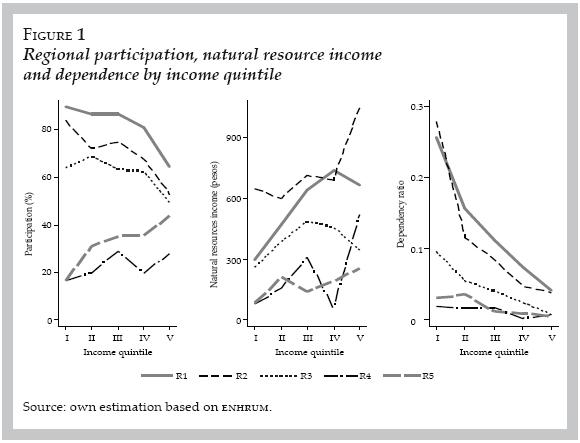
A negative relationship between participation and income is evident for regions 1, 2 and 3, but not for regions 4 and 5. In the latter two regions, participation increases with income: the participation rate rises sharply from quintile I (17% in both regions) to quintile V (nearly 30% in region 4 and 44% in region 5).
The average absolute value of natural resource income shows a general tendency to increase with total income in most of the regions. In fact, similar to what happens at the national level, within regions the richest households generate more income from natural resources than do households in the lower tail of the income distribution.
In spite of the higher participation in regions 4 and 5, the last panel of figure 1 shows that the relative importance of income from natural resources is not only negligible in those two regions but also decreases with income and represents less than 1% of the per–capita net income for households in the top 20% of the income distribution. For the rest of the regions, figure 1 shows a clear negative relationship between dependence and income.
As mentioned in the introduction, we are interested in quantifying the relationship between inequality at the community level and dependency. In this paper economic inequality is measured by the Gini coefficient calculated for each village from a household wealth index. The wealth index was constructed from variables measuring dwelling characteristics (i.e. number of rooms, availability of a separate room exclusive for cooking, quality of construction materials, and availability of electricity, bathroom and sewage) as well as dummy variables capturing ownership of durable goods (television, refrigerator, car and agricultural equipment).3
Figure 2 shows the relationship between wealth inequality and participation, natural resource income and dependency at the village level. Inequality in wealth varies considerably across villages (from 0.05 to 0.48, with an average of 0.16). Villages with higher inequality also tend to have higher participation rates, higher average income from resource extraction and higher average dependence ratios than villages with low inequality.4 This pattern is consistent with the hypothesis that inequality has an adverse effect on cooperation in the management of the commons, leading more people to collect resources and to do so in a more intensive way. Unfortunately, there is not enough information to perform a detailed test of this hypothesis. We take a tentative step in this direction by including inequality as an explanatory variable in the econometric analysis that follows, to control for wealth heterogeneity at the village level.
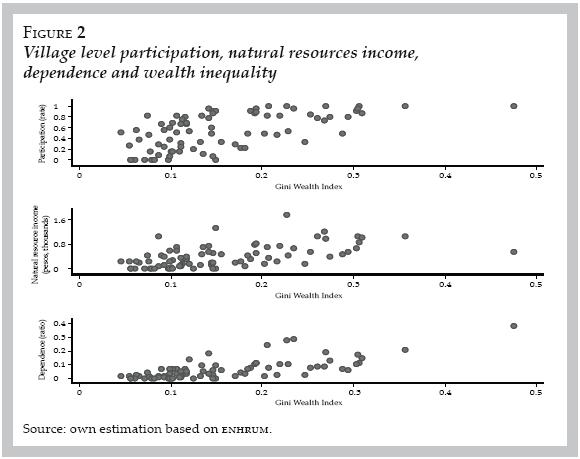
ESTIMATION AND RESULTS
The main objective of this section is to empirically identify the effects of household characteristics and inequality at the village level on the decision to participate on natural resource extraction and on households' dependence on natural resource income. Our estimation strategy is based on the assumption of an underlying process of household utility maximization. As a result of this process, some households decide to allocate some of their members' labor to natural resource extraction, while the optimal choice for other households is a corner solution in which nobody works in this activity. In our econometrics it is important to recognize this; it implies that income from resource extraction, and therefore dependence on that source of income, can take on a value of zero with positive probability and thus is censored.
In order to analyze the households' decision to participate in resource extraction the following probit model is used:

where Pi is an indicator variable that takes the value of one when the household i participates in resource extraction. Pi* is a latent variable, xi, is a vector of household and village level characteristics, and ui is an error term assumed to be normally distributed. Our main interest is in how the expected probability of participation (E(P|X)) changes with income and other explanatory variables.
To deal with the corner solution that leads to censoring when analyzing natural resource dependence we follow Wooldridge (2002) and estimate a tobit model:

where RDi measures natural resource dependence of household i. RDi* is a latent variable, xi is a vector of household and community level characteristics, and εi is a normally distributed error term. Our main interest is on the truncated mean (E(RD|X,RD > 0)) and its corresponding marginal effects. These two models provide the basic framework for the analysis that follows.
We begin by running a simple version of the probit model corresponding to equation [1] to estimate the relationship between income and participation in resource extraction as an income generating activity in rural Mexico. The only explanatory variables included in this regression are the natural logarithm of income and its square.5 With the estimated coefficients we calculate the expected probability of participation as a function of income. Figure 3 shows the results of this exercise. A clear inverted U–shaped pattern emerges. The probability of participation reaches its highest point (64%) at around 2 200 pesos (close to the average income of the households in the lowest quintile of the distribution). At the average income of the top quintile, the probability of participation decreases to around 30 per cent.
We follow a similar approach as a first step to estimate the relationship between natural resource dependence and income. Using the results of a tobit regression with the natural logarithm of income as the only explanatory variable, we construct the expected dependency ratio for the households that participated in extraction.6 Figure 4 shows that resource dependency decreases with income, from close to 40% of income for the poorest households to less than 10% for the richest ones.
Figures 3 and 4 illustrate gross relationships between participation and dependency, on one hand, and income, on the other. As a second step, we control for other variables that might influence resource exploitation by affecting households' access to other (more remunerative) income generating activities. These variables include the following household characteristics: age, gender and education of the household head, number of household members with at least high school completed, land, and a wealth index. We also include the village level Gini of the wealth index, which as shown before is highly correlated with both variables of interest and can arguably proxy for the degree of socioeconomic heterogeneity at the village level. Finally, we include a set of regional dummies to account for the important regional differences that were illustrated in the previous section.
Results presented in table 2 show that households with a male as head are 10% less likely to participate in resource extraction than those with a female head. Households with older household heads are more likely to participate in the activity (the square of age was not significant and was dropped from the regression). An extra year of household–head education decreases the probability of participation by 1%. The education of other household members has a negative although statistically insignificant effect. These results suggest that education permits households to allocate their time to more remunerative activities than resource extraction and collection.
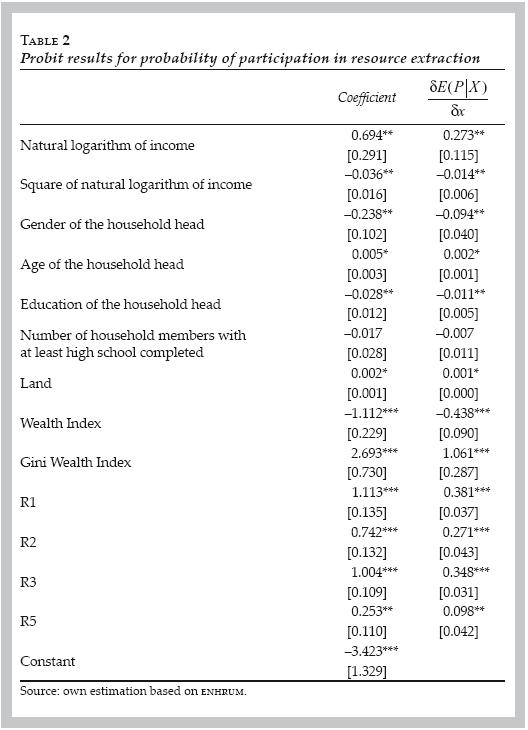
Households with more land are more likely to participate in extraction, but the effect is not very significant in magnitude or statistically: An additional hectare of land is associated with an increase in the probability of participation of 0.1%. On one hand, access to land encourages on–farm work, which might be complemented with income from natural resource extraction. On the other hand, for landed agricultural households engaged in crop production, the opportunity cost of resource extraction might be high, and this would lower the probability of extraction. These opposing effects might explain the low significance and low value of the land coefficient.
The wealth index has a strong negative association with the probability of participation. Households rich in assets are less likely to participate in resource extraction. In contrast, inequality in the village distribution of wealth increases the probability of participation, offering support for the hypothesis that socioeconomic inequality discourages the creation of rules (or enforcement) in the management of the resource. Finally, the regional dummies are highly significant. The region of reference (region 4) has the lowest level of participation; location in any other region, ceteris paribus, increases the probability of participation. The region fixed effect ranges from a 10% increase in the probability of participation in resource extraction (region 5) to 38% (region 1). Controlling for all of these variables, the effect of income is relatively unchanged; that is, it is similar to the one illustrated in figure 3.
Table 3 presents the results for resource dependence. Wealthier households are less dependent on resource extraction than poor households, and households that live in communities with higher inequality in the distribution of wealth are more dependent on natural resource extraction than their counterparts in more egalitarian communities. The dependency ratio of households that participate in extraction and have a male head is 0.01 smaller than the ratio of households with the same characteristics but with a female head. As is the case for the probability of participation, age has a positive but negligible effect on the dependency ratio. The education variables have the expected signs but are not significant. Education affects the decision to participate in the activity but not the degree of dependence on that activity. Land has a positive but very small effect on resource dependence. The regional differences prevail except for region 5; location has a very important impact on the dependence ratio.
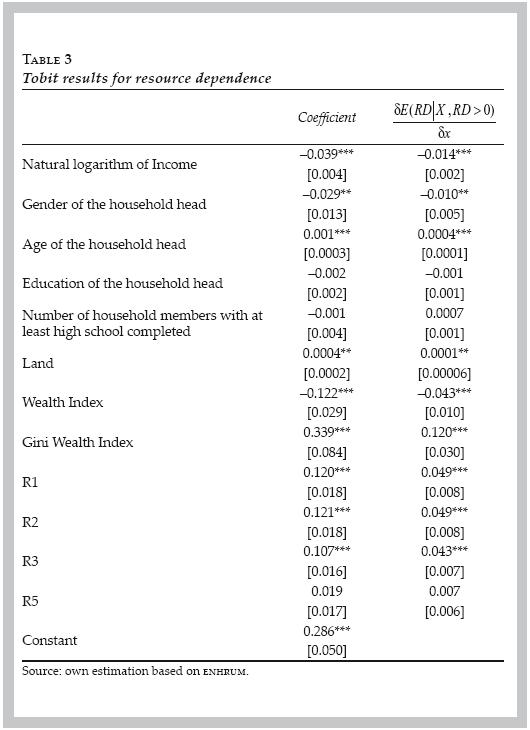
Given the important differences across regions underscored in tables 2 and 3 in terms of both the probability of participation and the dependence on natural resources, our final step is to estimate a separate probit and tobit for each one of the five regions with all the explanatory variables included as regressors. Instead of presenting all of the results for each region, we concentrate on the relationship between income and resource participation or dependence. Figures 5 and 6 show the predicted values for each region given the respective probit/tobit estimations. The horizontal axis of each panel shows the lowest and highest per–capita income as well as the upper bound for the first and fourth quintiles.
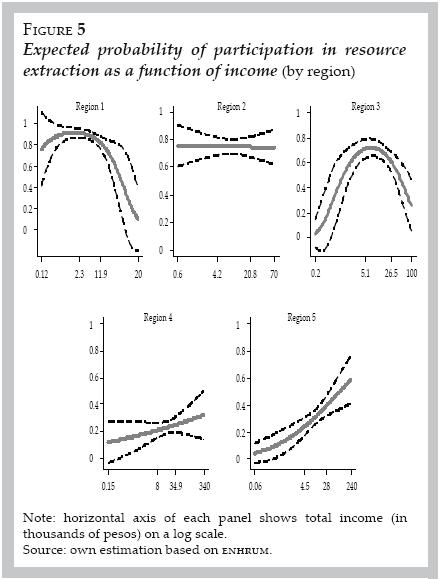
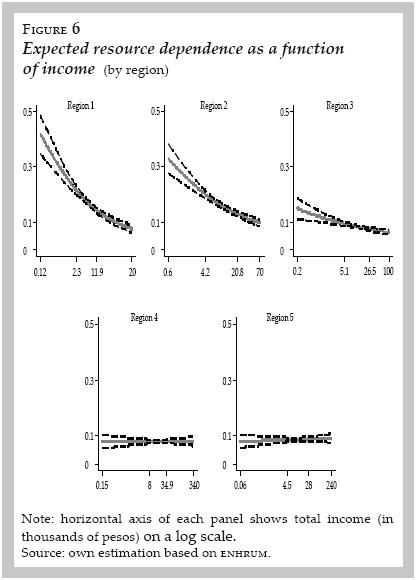
The regional analysis shows that the probability of participation has an inverted–u shape for regions 1 and 3. In region 1 the probability of participation reaches a maximum of 92% in households with income close to 1 500 and it decreases thereafter. At the upper tail of the distribution of observed values, the probability of participation is still relatively high. Given that 80% of the households in this region have an income lower than 12 000, the predicted probability of participation is high for most households in the sample. The expected probability for region 3 has a similar shape, but its maximum is smaller (72%). Only 20% of the households in region 3 have an income lower than 5 100, and 75% have an income below 22 400. This means that for most of the households in this region the predicted probability of participation is between 64 and 72 per cent.
In region 2, the probability of participation appears independent of the income distribution. In regions 4 and 5 the probability increases with income, but the quantitative changes are very different in the two regions. In region 4 the probability starts close to 20% and never goes beyond 35%; in fact, given the income distribution, the expected probability is smaller than 24% for 80% of the households in the sample. In region 5 the probability goes from close to zero in the lower tail of the income distribution to 37% at the mean (20 881). It is between 33% and 39% in households in the fourth quintile of the income distribution and close to 60% for households at the upper tail of the distribution.
Figure 6 shows a clear pattern of diminishing dependence as income increases in regions 1 and 2. In region 1, the predicted dependence ratio goes from 0.42 for households that extract and are at the lower tail of the income distribution to less than 0.14 for those in the top quintile. Predicted dependence in region 2 goes from 0.33 to 0.13 for the same quintiles. In region 3 there is also a negative correlation between income and dependence, but with a much more modest impact (from 0.15 for those in the lowest quintile to less than 0.08 in the highest). In regions 4 and 5, dependence is basically independent of the income distribution. Even though participation increases with income in these two regions, income from natural resources is still a relatively unimportant component of total income.
Conclusions
Researchers, policy makers and development practitioners frequently assume that rural households in developing countries are dependent on natural resources (Mamo et al. 2007). Our results show that in fact natural resource extraction is an important source of income for a large number of rural Mexican households. Without it, many poor households' ability to satisfy their basic needs would be jeopardized. However, rural households are heterogeneous. Our results show that natural resource extraction is predominantly an activity of poor households: Participation is lower in high income quintiles. The same is true for dependence on natural resource income. Income from natural resources represents on average 16% of total income in the poorest quintile of Mexico's rural population but only 1% in the top quintile.
Inequality in the distribution of wealth at the village level has a positive and significant correlation with both participation and dependence. This finding is consistent with the hypothesis that village heterogeneity has an adverse effect on cooperation in the management of the commons, leading more people to collect resources and to do so in a more intensive way. Additional research clearly is required to establish a causal relationship between inequality and conservation incentives.
We also show that there are important differences across Mexico in terms of both participation and dependence on resource income. These differences are most evident between the south and north of the country. The south is characterized by high participation rates and relatively high dependence for most households. The north has low participation (although it increases with income) and very low dependence. The reasons for this contrast are probably multifaceted. Analyzing this in detail is beyond the scope of the present work, but a likely explanation is the relative abundance of natural resources and the relative scarcity of off–farm employment opportunities that characterize the south compared with the north.
High levels of dependence reflect the importance of natural resources for the rural poor and therefore suggest the effect that the health and governance of these resources can have on poverty alleviation. In this respect, our findings underline the importance of environmental policies, particularly in the south. On the other hand, our results also show that when relatively rich households participate in natural resource extraction, their natural resource income is considerably higher than that of the poor. Thus, while worrying about interrelationships between poverty and resource extraction, policy makers should not overlook the environmental impact of relatively rich rural households: It is possible that in many instances rich households put more pressure on the environment than do the poor. More research is necessary on differences in resource extraction behavior between rich and poor households to inform public policies aimed at achieving both environmental sustainability and poverty alleviation in rural areas.
REFERENCES
Angelsen, A. and S. Wunder, "Exploring the forest–poverty link: key concepts, issues and research implications", Center for International Forestry Research (CIFOR), CIFOR Occasional Paper no. 40, 2003. [ Links ]
Baland, J.M.; P. Bardhan; S. Das; D. Mookherjee and R. Sarkar, "Inequality, collective action, and the environment: evidence from firewood collection in Nepal", in J.M. Baland, P. Bardhan and S. Bowles, Inequality, Cooperation and EnvironmentalSustainability, Princeton University Press, 2007. [ Links ]
Baland. J. and J.P. Platteau, "Wealth inequality and efficiency in the commons, Part I: The unregulated case", Oxford Economic Papers no. 49, 1997, pp. 451–482. [ Links ]
Baland. J. and J.P. Platteau, "The ambiguous impact of inequality on local resource management", World Development, vol. 27(5), 1999, pp. 773–788. [ Links ]
Cavendish, W, "Poverty, inequality and environmental resources: quantitative analysis of rural households", Center for the Study of African Economies, Working Paper Series no. 99–9, 1999. [ Links ]
Escobal, J. and U. Aldana, "Are nontimber forest products the antidote to rainforest degradation? Brazil nut extraction in Madre de Dios, Peru", World Development, vol. 31(11), 2003, pp. 1873–1887. [ Links ]
Filmer, D. and L. Pritchett, "Estimating wealth effects without expenditure data or tears: an application to educational Enrollments in States of India", Demography, no. 38, 2001, pp. 115–132. [ Links ]
Fisher, M., 'Household welfare and forest dependence in Southern Malawi', Environment and Development Economics, no. 9, 2004, pp. 135–154. [ Links ]
Guha, R. and J. Martínez–Alier, Varieties of Environmentalism: Essays North and South, London, Earthscan Publications Ltd., 1997. [ Links ]
Jodha, N.S., "Common property resources and rural poor in dry regions of India", Economic and Political Weekly, no. 11, 1986, pp. 1169–1181. [ Links ]
López–Feldman, A.; J. Mora and J.E. Taylor, "Does natural resource extraction mitigate poverty and inequality? Evidence from rural Mexico and a Lacandona rainforest community", Environment and Development Economics, no. 12, 2007, pp. 251–269. [ Links ]
Mahapatra, K. A.; H. Albers and E. Robinson, 'The impact of NTFP sales on rural households' cash income in India's dry deciduous forest", Environmental Management, no. 35, 2005, pp. 258–265. [ Links ]
Mamo, G.; E. Sjaastad and P. Vedeld, "Economic dependence on forest resources: a case from Dendi District, Ethiopia", Forest Policy and Economics, no. 9, 2007, pp. 916–927. [ Links ]
Martínez–Alier, J., The environmentalism of the poor: A study of ecological conflicts and valuation, Northampton, Edward Elgar Pub., 2002. [ Links ]
Narain, U.; S. Gupta and K. Van't Veld, "Poverty and resource dependence in rural India", Ecological Economics, no. 66, 2008, pp. 161–176. [ Links ]
Reddy, S. and S. Chakravarty, "Forest dependence and income distribution in a subsistence economy: evidence from India", World Development, no. 27, 1999, pp. 1141–1149. [ Links ]
Teruel, G.; L. Rubalcava and A. Santana, "Escalas de equivalencia en México", en M. Szekeley, (coordinator), Números que mueven al mundo: la medición de la pobreza en México, México, Editorial Porrúa, 2005. [ Links ]
Vedeld, P.; A. Angelsen;J. Bojo; E. Sjaastad and G. Kobugabe, "Forest environmental incomes and the rural poor", Forest Policy and Economics, no. 9, 2007, pp. 869–879. [ Links ]
Wooldridge, J., Econometric Analysis of Cross Section and Panel Data, Cambridge, MIT Press, 2002. [ Links ]
Wunder, S., "Poverty alleviation and tropical forests — What scope for synergies?", World Development , vol. 29, 2001, pp. 1817–1833. [ Links ]
* The authors wish to thank two anonymous referees for their valuable comments and suggestions.
** JEL: Journal of Economic Literature–Econlit.
1 It is important to emphasize that in this paper we focus on natural resources as a mean to sustain and improve livelihood and that we do not make any claims about efficiency in the use of natural resources nor about their intrinsic value. Therefore, following the classification of the different perspectives to approach the relationship between humans and the environment proposed by Guha and Martínez–Alier (1997) and Martínez–Alier (2002), our analysis could be considered as belonging to what they call "the environmentalism of the poor'.
2 The inputs used by households vary not only across activities but also across communities. For example, fishing in some communities requires buying fuel and maintaining boats, while in other communities the only inputs are family labor and a fishing rod. The community surveys allowed us to capture these differences by adapting the household survey form to the specific characteristics of each community.
3 This index was created using principal components analysis and it captures the largest amount of information common to all the dwelling and durable goods variables. The methodology is explained in Filmer and Pritchett (2001) The Stata command pca was used to estimate the index.
4 Results from three simple linear regressions at the village level with the Gini of the wealth index as only explanatory variable show that this variable has a high explanatory power over either participation, income from the source or dependency. The R2 were, respectively 0.35, 0.31 and 0.51.
5 Both variables are statistically significant at the 1% level.
6 The income–squared term was not statistically significant and was dropped from the estimation.














